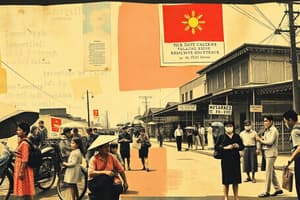Podcast
Questions and Answers
Who were the peninsulares in the Philippine social structure of the 19th century?
Who were the peninsulares in the Philippine social structure of the 19th century?
Which term was used to refer to native Filipinos during the Spanish colonial period?
Which term was used to refer to native Filipinos during the Spanish colonial period?
What characterized the relationship between Spaniards and native Filipinos under Spanish colonial rule?
What characterized the relationship between Spaniards and native Filipinos under Spanish colonial rule?
Who made up the upper class in the social structure of the 19th century Philippines?
Who made up the upper class in the social structure of the 19th century Philippines?
Signup and view all the answers
What does the term 'insulares' refer to in the context of 19th century Philippine society?
What does the term 'insulares' refer to in the context of 19th century Philippine society?
Signup and view all the answers
Who were considered part of the highest class in the social structure during Spanish colonial rule?
Who were considered part of the highest class in the social structure during Spanish colonial rule?
Signup and view all the answers
What term was specifically given to full-blooded Spaniards born in the colonies?
What term was specifically given to full-blooded Spaniards born in the colonies?
Signup and view all the answers
Which group was primarily responsible for opening the first schools for Filipino native children?
Which group was primarily responsible for opening the first schools for Filipino native children?
Signup and view all the answers
Which social class was viewed as inferior and largely denied access to higher education during the Spanish colonial period?
Which social class was viewed as inferior and largely denied access to higher education during the Spanish colonial period?
Signup and view all the answers
What was one of the focuses of the education provided in parochial schools under the control of the friars?
What was one of the focuses of the education provided in parochial schools under the control of the friars?
Signup and view all the answers
Study Notes
Social and Political Structure in 19th Century Philippines
- Peninsulares: Spaniards born in Spain, wielded political power and held important government positions.
- Insulares: Also known as criollos, these were Spaniards born in the Philippines; sometimes referred to as Filipinos.
- Indios: Term for native Filipinos, considered lower class.
- Mestizos: Individuals of mixed ancestry, such as Chinese-Filipino or Spanish-Filipino heritage.
Evolution of the Term "Filipino"
- The term "Filipino" was officially used after 1898, denoting natives of the Philippines post-Spanish rule.
Filipino Social Structure
- Feudalism: Introduced by the Spanish, establishing a master-slave dynamic with natives as tenants of their own land.
- Taxation and Forced Labor: Spanish government imposed taxes and required natives to render forced labor (polo y servicio).
Social Pyramid
- Upper Class: Comprised of peninsulares, Spanish officials, and friars; smallest segment but held significant authority.
- Middle Class: Included insulares, mestizos, and principalia (native elites like gobernadorcillos and heads of barangay).
- Lower Class: Comprised solely of indios, representing the poor native population facing oppression from the higher classes.
Racial Discrimination
- Institutionalized racial discrimination was prevalent; lower classes faced social and educational restrictions, limiting access to opportunities.
Education System
- Parochial Schools: First established by missionaries, focused primarily on religious education while neglecting comprehensive learning.
- Separate Colleges for Boys and Girls: Educated mestizos and, later, native Filipinos; subjects included history, mathematics, Latin, etc.
- Educational Decree of 1853: Mandated establishment of elementary schools for boys and girls in each town, aimed at increasing educational access.
Political System
- Centralized Governance: Governed directly by Spanish Crown via the Ministry of Colonies; all policies originated from Manila.
- Governor-General: Represented the Crown, commanded the military, presided over religious appointments, and had legislative powers.
Local Governance
- Alcaldias: Governed pacified provinces, managed day-to-day operations, and ensured tax collection.
- Corregimiento: Represented unpacified provinces, still subject to Spanish control.
Oversight Mechanism
- Residencia: A judicial court established to evaluate the performance of the governor-general upon their replacement.
Studying That Suits You
Use AI to generate personalized quizzes and flashcards to suit your learning preferences.
Related Documents
Description
Explore the social and political structures of the Philippines during the 19th century in this lesson. Learn key terms such as Peninsulares and Insulares, and understand their impact on Filipino society. This quiz will enhance your knowledge of historical dynamics in the Philippines.




